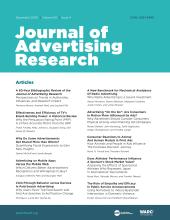Abstract
Why do some advertisements get shared more than others? Using scalable automated facial coding algorithms, the authors quantified the facial expressions of thousands of individuals in response to hundreds of video advertisements. Results suggest that not all emotions increase sharing and that the relationship between emotion and transmission is more complex than mere valence alone. Facial actions linked to positive emotions, (e.g., smiles) were associated with increased sharing. Although some actions associated with negative emotion (e.g., lip depressor associated with sadness) were linked to decreased sharing, others (e.g., nose wrinkles) associated with disgust were linked to increased sharing.
- Received April 14, 2020.
- Received (in revised form) June 10, 2020.
- Accepted July 31, 2020.
- Copyright © 2020 ARF. All rights reserved.
ARF MEMBERS
If you are a member of the Advertising Research Foundation, you can access the content by logging in here
Log In
Pay Per Article - You may access this article (from the computer you are currently using) for 30 days for US$20.00
Regain Access - You can regain access to a recent Pay per Article purchase if your access period has not yet expired.





